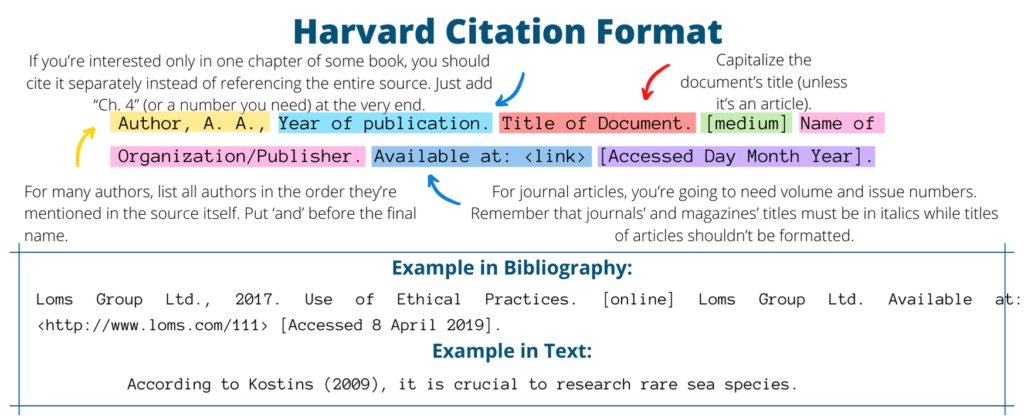Bibliography is as important as in-text citations because it helps your readers see how credible your sources are and where/how they can be found. You have to list them alphabetically based on an author’s last name. When locating several publications by one author, place them according to the earliest date.
Articles
For journal articles, you’re going to need volume and issue numbers. Remember that journals’ and magazines’ titles must be in italics while titles of articles shouldn’t be formatted. For academic journals, this general structure is needed.
Author, A. A., Year of publication. Title of Article. Name of Journal, issue(volume), page numbers.
See below for clearer articles referencing structure understanding.
Meltansit, F., 2013. Fiction Does Not Affect Reality. Life Studies, 32(2), pp.32-65.
For online newspapers’ articles, the following structure is needed:
Author, A. A., Year of publication. Title of Article. Name of Magazine, [medium] Day Month. Available at: <link>[Accessed Day Month Year].
Javris, L. K., 2019. Another Triumph. New York Times, [online] 2 July. Available at: <http://www.newyorktimes.com/news/1/222>[Accessed 8 April 2019].
Electronic Websites
There are many kinds of useful websites. To cite them, just use all available info. Capitalize the document’s title (unless it’s an article).
Author, A. A., Year of publication. Title of Document. [medium] Name of Organization/Publisher. Available at: <link>[Accessed Day Month Year].
Loms Group Ltd., 2017. Use of Ethical Practices. [online] Loms Group Ltd. Available at: <http://www.loms.com/111> [Accessed 8 April 2019].
Chapter From a Book
If you’re interested only in one chapter of some book, you should cite it separately instead of referencing the entire source. Just add “Ch. 4” (or a number you need) at the very end. If this book has editors, mention them but start reference from name of the author whose chapter/story you’ve used. Mention the date of a specific story and of book itself. It’ll look like this:
Author, A. A., Year of publication. Chapter’s title. In: E. Editor, ed. Year of publication. Book’s Title. Location: Publisher. Ch. number.
Jones, J., 2015. Overcoming Trauma. In: L. Stuart, ed. 2018. Learning How to Deal with Disorders. Cambridge: Cambridge University Press. Ch.4
E-books
In our modern time, e-books are increasingly popular. When using one, mention what you normally would about published professionals but add a link through which it was accessed.
Author, A. A., Year of publication. Book’s Title. [e-book] Location: Publisher. Available through: Database website <link> [Accessed Day Month Year].
Rolins, B., 2012. Things That Matter. [e-book] Philadelphia, PA: Wol Press. Available through: PA Wol University Library website <https://111.22> [Accessed 8 April 2019].
Conference Papers
Be very attentive when citing academic conference papers. Mention all data provided below:
Author, A. A., Year of publication. Paper’s Title. In: Name of Organization, conference’s name. Location, Date Month Year. Location of where conference’s transcript was published: Publisher.
White, M. L., 2018. Determining benefits of a new Breakthrough Plan. In: UNDESA (United Nations Department of Global Communications), 3rd International forum on technological advancements. San Francisco, US, 13-15 June 2010. New York: United Nations.
Books with One Author
General Harvard referencing for books will look like this.
Author, A. A., Year of publication. Book’s Title. Location: Publisher.
Don’t forget that books’ titles must be capitalized and see specific examples for more clarity.
Broks, L. K., 2010. Sea Explorations. Newbury Park, CA: Sage.
For editions other than first, place number of the edition after title.
Broks, L. K., 2010. Sea Explorations. 3rd ed. Newbury Park, CA: Sage.
Books with Many Authors
For many authors, use the Harvard referencing generator to avoid mistakes. If you’re doing it manually, remember that you must list all authors in the order they’re mentioned in the source itself. Put ‘and’ before the final name.
Author, A. A. and Author, B. B., Year of publication. Book’s Title. Location: Publisher.
Check a more specific example below.
Joris, K., Morgan, S. and Babers, U. K., 2016. Conducting Research of Level 2. Cambridge: Cambridge University Press.
Patents
For patents, check this template.
Inventor, I. I., Assignee. Year of Patent. Patent’s title. Location. Patent number.
Wovson, R., Unique Glasses Limited. 2014. New ultra-violet method of glass manufacturing. US. Pat. 9,452,479.
Lecture Notes
When using lecture notes provided by the professor, Harvard referencing generator won’t be able to help. If you’re providing a paper for an audience who’s not your professor, include them in Appendix.
Lecturer, L. L., Year of Publication. Notes’ title, module number-title. Location, status. (See appendix A)
Brown, B. L., 2011. Sea species exploration, SF32653L Marine Studies. University of Delaware, unpublished. (See appendix X)

